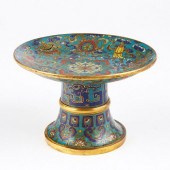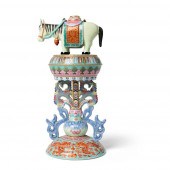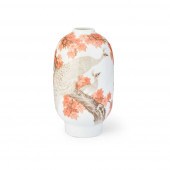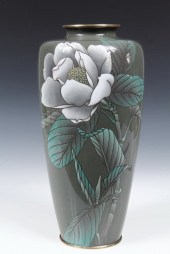Pricing Guides & Dictionary of Makers Marks for Antiques & Collectibles

A few examples of appraisal values for
IMPERIAL CLOISONNE
Search our price guide for your own treasures
-
 CHINESE IMPERIAL MID-QING CLOISONNE
CHINESE IMPERIAL MID-QING CLOISONNE RITUAL DISHChinese mid-Qing dynasty Imperial cloisonne ritual dish. This shallow dish is raised on a stem-like base with a splayed foot decorated in colorful enamels against a light blue ground to show the eight Buddhist emblems. A nearly identical dish is seen in the Imperial palace. Please see "Compendium of Collections in the Palace Museum: Enamels 4, Cloisonne in the Qing Dynasty (1644-1911)," Beijing: The Forbidden City Publishing House, 2011, pp. 30-31 for the example in the Palace Museum collection. Please note the book is NOT included this lot and is for illustrative purposes only. Height: 4 1/2 in x diameter: 7 in. Condition: Very good condition. Light wear to the gilding, particularly to foot rim. The top is slightly loose from the bottom. No restorations. Please contact us for a detailed condition report. Please note that the lack of a condition statement does not imply perfect condition. Email condition@revereauctions.com with any condition questions.
CHINESE IMPERIAL MID-QING CLOISONNE
CHINESE IMPERIAL MID-QING CLOISONNE RITUAL DISHChinese mid-Qing dynasty Imperial cloisonne ritual dish. This shallow dish is raised on a stem-like base with a splayed foot decorated in colorful enamels against a light blue ground to show the eight Buddhist emblems. A nearly identical dish is seen in the Imperial palace. Please see "Compendium of Collections in the Palace Museum: Enamels 4, Cloisonne in the Qing Dynasty (1644-1911)," Beijing: The Forbidden City Publishing House, 2011, pp. 30-31 for the example in the Palace Museum collection. Please note the book is NOT included this lot and is for illustrative purposes only. Height: 4 1/2 in x diameter: 7 in. Condition: Very good condition. Light wear to the gilding, particularly to foot rim. The top is slightly loose from the bottom. No restorations. Please contact us for a detailed condition report. Please note that the lack of a condition statement does not imply perfect condition. Email condition@revereauctions.com with any condition questions. -
 ASIAN: PAIR OF IMPERIAL CLOISONNE
ASIAN: PAIR OF IMPERIAL CLOISONNE FIGURES ON THRONE, 20TH C., CHINESE, EMPEROR AND EMPRESS FIGURES DRESSED IN LAVISH CLOISONNE ENAMEL ROBES WITH TURQUOISE BEADED FILIGREE HEADDRESS, RESIN FLESH, IN CARVED WOOD WITH BR...ASIAN: Pair of Imperial cloisonne figures on throne, 20th C., Chinese, Emperor and Empress figures dressed in lavish cloisonne enamel robes with turquoise beaded filigree headdress, resin flesh, in carved wood with brass wire inlaid and gilt metal mounted throne and platform, having carved and painted bone phoenix plaque on stairs, wear consistent with age and use, figures only: 13" h.; overall: 15" h. x 12" w. x 8 3/4" d.
ASIAN: PAIR OF IMPERIAL CLOISONNE
ASIAN: PAIR OF IMPERIAL CLOISONNE FIGURES ON THRONE, 20TH C., CHINESE, EMPEROR AND EMPRESS FIGURES DRESSED IN LAVISH CLOISONNE ENAMEL ROBES WITH TURQUOISE BEADED FILIGREE HEADDRESS, RESIN FLESH, IN CARVED WOOD WITH BR...ASIAN: Pair of Imperial cloisonne figures on throne, 20th C., Chinese, Emperor and Empress figures dressed in lavish cloisonne enamel robes with turquoise beaded filigree headdress, resin flesh, in carved wood with brass wire inlaid and gilt metal mounted throne and platform, having carved and painted bone phoenix plaque on stairs, wear consistent with age and use, figures only: 13" h.; overall: 15" h. x 12" w. x 8 3/4" d. -
 FAMILLE ROSE 'HORSE' ALTAR EMBLEM
FAMILLE ROSE 'HORSE' ALTAR EMBLEM QIANLONG MARK BUT REPUBLIC PERIOD ?? ??? ????????of columnar form, on top of the drum-shaped podium surmounted by a horse standing on all fours covered with a cloth bearing a stand, the podium raised on an openwork foliated stem issuing from a double-gourd flanked with ribbons supported on a dome foot painted with dragons, the base with a six-character Qianlong mark within double squares in iron-red(1)23.2cm highNote: The present alter emblem is one of the Seven Regal Treasures, Qizhenbao, in Buddhism. These Seven Treasures, also known as the Seven Jewels of Royal Power, as described in the Buddhist sutra, were brought to earth by the Universal Monarch- Chakravartin. These saptaratna serve as the indispensable symbols for the governance of a 'wheel turning sage king'. They include the Elephant, symbolising sovereignty and opulence; the Wheel, representing the Buddhist doctrine; the Horse, representing facility in war and mobility; the Wish-Granting Jewel; the Queen who serves as the virtuous wife to the king; the Minister who is responsible for the welfare of the people; and the General who holds authority over the military troops for peace.A comparable example of a famille rose horse altar emblem, Qianlong mark and period, was sold together with an elephant altar emblem, at Christie's London, 8 Jun 2004, lot 437; Two famille rose 'Minister' and 'Woman' altar emblems, Qianlong mark and period, were offered at Sotheby's Hong Kong, 08 October 2008, lot 2608; a pair of 'Flaming Pearl' altar emblems, Qianlong mark and period, were offered at Sotheby's Hong Kong, 04 October 2016, lot 106.A number of sets of the ‘Seven Regal Treasures’ are known in various materials; for example a rare group of seven imperial cloisonne enamel, gilt bronze and white jade alter emblems, in which three are the Seven Treasures, and four are the Eight Buddhist Emblems, dated to Qianlong period, were sold at Christie's, 3 Dec 2008, lot 2601; a parcel-gilt full set of Seven Regal Treasures are in the collection of Bodhimanda Foundation, accession no V-851
FAMILLE ROSE 'HORSE' ALTAR EMBLEM
FAMILLE ROSE 'HORSE' ALTAR EMBLEM QIANLONG MARK BUT REPUBLIC PERIOD ?? ??? ????????of columnar form, on top of the drum-shaped podium surmounted by a horse standing on all fours covered with a cloth bearing a stand, the podium raised on an openwork foliated stem issuing from a double-gourd flanked with ribbons supported on a dome foot painted with dragons, the base with a six-character Qianlong mark within double squares in iron-red(1)23.2cm highNote: The present alter emblem is one of the Seven Regal Treasures, Qizhenbao, in Buddhism. These Seven Treasures, also known as the Seven Jewels of Royal Power, as described in the Buddhist sutra, were brought to earth by the Universal Monarch- Chakravartin. These saptaratna serve as the indispensable symbols for the governance of a 'wheel turning sage king'. They include the Elephant, symbolising sovereignty and opulence; the Wheel, representing the Buddhist doctrine; the Horse, representing facility in war and mobility; the Wish-Granting Jewel; the Queen who serves as the virtuous wife to the king; the Minister who is responsible for the welfare of the people; and the General who holds authority over the military troops for peace.A comparable example of a famille rose horse altar emblem, Qianlong mark and period, was sold together with an elephant altar emblem, at Christie's London, 8 Jun 2004, lot 437; Two famille rose 'Minister' and 'Woman' altar emblems, Qianlong mark and period, were offered at Sotheby's Hong Kong, 08 October 2008, lot 2608; a pair of 'Flaming Pearl' altar emblems, Qianlong mark and period, were offered at Sotheby's Hong Kong, 04 October 2016, lot 106.A number of sets of the ‘Seven Regal Treasures’ are known in various materials; for example a rare group of seven imperial cloisonne enamel, gilt bronze and white jade alter emblems, in which three are the Seven Treasures, and four are the Eight Buddhist Emblems, dated to Qianlong period, were sold at Christie's, 3 Dec 2008, lot 2601; a parcel-gilt full set of Seven Regal Treasures are in the collection of Bodhimanda Foundation, accession no V-851 -
 FAMILLE ROSE 'MAPLE AND PEACOCK'
FAMILLE ROSE 'MAPLE AND PEACOCK' VASE BY ZHAI XIAOXIANG (1944- ) 1995 ???? ???? ?????? ???????????????the lantern-shaped oval body supported on a tall straight foot and terminating to a short inverted mouth rim, the body finely painted with two white peacocks perching on a large maple tree, one side inscribed with the title 'Hong Shuang Su Yu (Red maples with plain feathers)', dated to the Spring of Yi Hai year, corresponding to 1995, signed 'Zhai Xiao Xiang'(1)17.3cm highProvenance: Private English collection, London; acquired from Peter Wain, Shropshire during 25th February and 3rd March 1997 at the Olympia Fine Art and Antique Fair, with an original handwritten receipt which states the piece dates to Spring 1995, together with a certification states this vase 'was exhibited at the Olympia London demonstration and exhibition of Master Zhai Xiao Xiang of Jingdezhen, China and is certified an original work by the Master', signed by the artist and the dealer, the base inscribed with 'Jing De Zhen Zhi (Made in Jingdezhen)' mark in double squareNote: Mr Zhai Xiaoxiang is one of eight Senior Masters currently working in Jingdezhen and the only one still painting in the traditional Imperial style. He was born in 1944 in Poyang county, Jiangxi Province. In 1955, he won a scholarship to the Art and Ceramics Training School, attached to the Art Porcelain Factory of Jingdezhen. During his time at the School he quickly earned a reputation for his excellent bird and flower painting. In 1975, he was invited by the Palace Museum, Beijing, to reproduce a copy, a porcelain, of a famous Kangxi Imperial cloisonne vase. The perfect work earned him not only the admiration of the museum and the industry in Jingdezhen but also a gold medal award from the President of the Chinese Republic. He is now a Consultant at the Jingdezhen Art College and the Deputy Director of the Jingdezhen Ceramic Research Institute, and his works are passionately collected in Taiwan, Hong Kong and Japan with a waiting list for his latest masterpieces.A comparable vase with overglaze decoration of birds on a rock was painted by Zhia Xiaoxiang himself and given to V&A during the Olympia Fine Art and Antique Fair in February 1997, accession numberFE.66-1997
FAMILLE ROSE 'MAPLE AND PEACOCK'
FAMILLE ROSE 'MAPLE AND PEACOCK' VASE BY ZHAI XIAOXIANG (1944- ) 1995 ???? ???? ?????? ???????????????the lantern-shaped oval body supported on a tall straight foot and terminating to a short inverted mouth rim, the body finely painted with two white peacocks perching on a large maple tree, one side inscribed with the title 'Hong Shuang Su Yu (Red maples with plain feathers)', dated to the Spring of Yi Hai year, corresponding to 1995, signed 'Zhai Xiao Xiang'(1)17.3cm highProvenance: Private English collection, London; acquired from Peter Wain, Shropshire during 25th February and 3rd March 1997 at the Olympia Fine Art and Antique Fair, with an original handwritten receipt which states the piece dates to Spring 1995, together with a certification states this vase 'was exhibited at the Olympia London demonstration and exhibition of Master Zhai Xiao Xiang of Jingdezhen, China and is certified an original work by the Master', signed by the artist and the dealer, the base inscribed with 'Jing De Zhen Zhi (Made in Jingdezhen)' mark in double squareNote: Mr Zhai Xiaoxiang is one of eight Senior Masters currently working in Jingdezhen and the only one still painting in the traditional Imperial style. He was born in 1944 in Poyang county, Jiangxi Province. In 1955, he won a scholarship to the Art and Ceramics Training School, attached to the Art Porcelain Factory of Jingdezhen. During his time at the School he quickly earned a reputation for his excellent bird and flower painting. In 1975, he was invited by the Palace Museum, Beijing, to reproduce a copy, a porcelain, of a famous Kangxi Imperial cloisonne vase. The perfect work earned him not only the admiration of the museum and the industry in Jingdezhen but also a gold medal award from the President of the Chinese Republic. He is now a Consultant at the Jingdezhen Art College and the Deputy Director of the Jingdezhen Ceramic Research Institute, and his works are passionately collected in Taiwan, Hong Kong and Japan with a waiting list for his latest masterpieces.A comparable vase with overglaze decoration of birds on a rock was painted by Zhia Xiaoxiang himself and given to V&A during the Olympia Fine Art and Antique Fair in February 1997, accession numberFE.66-1997 -
 CLOISONNE VASE - Japanese Meiji
CLOISONNE VASE - Japanese Meiji Imperial Cloisonne Vase worked over a silver base with raised dimensional depiction of hibiscus flower on olive green ground circa 1880 10 3/4'' (27.3 cm) tall 4 1/2'' (11.4 cm) diam in the original padded wooden case
CLOISONNE VASE - Japanese Meiji
CLOISONNE VASE - Japanese Meiji Imperial Cloisonne Vase worked over a silver base with raised dimensional depiction of hibiscus flower on olive green ground circa 1880 10 3/4'' (27.3 cm) tall 4 1/2'' (11.4 cm) diam in the original padded wooden case
...many more examples with full details are available to our members - Learn more


